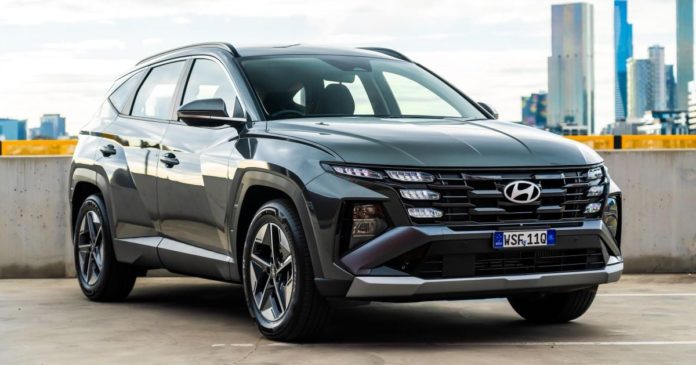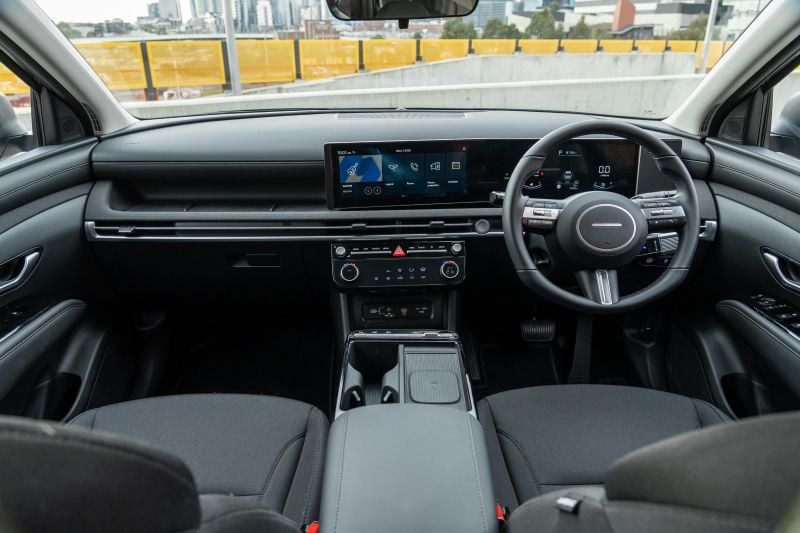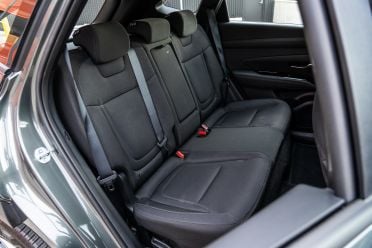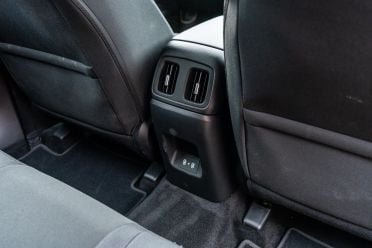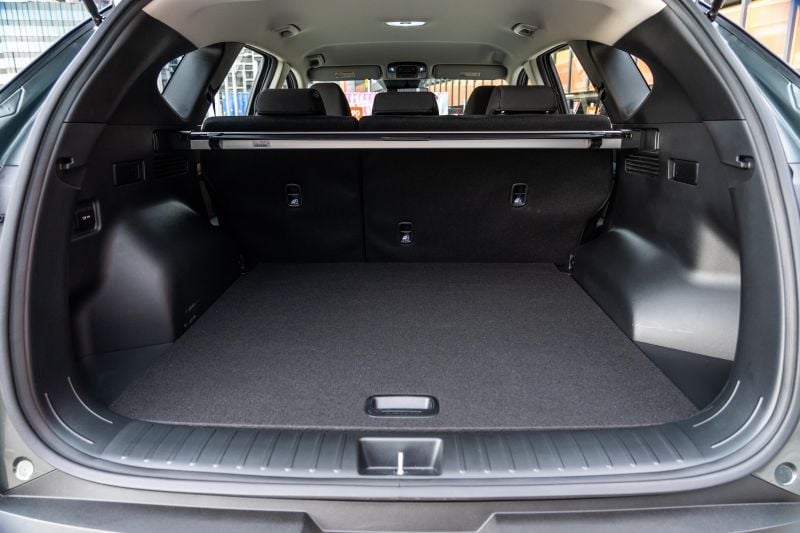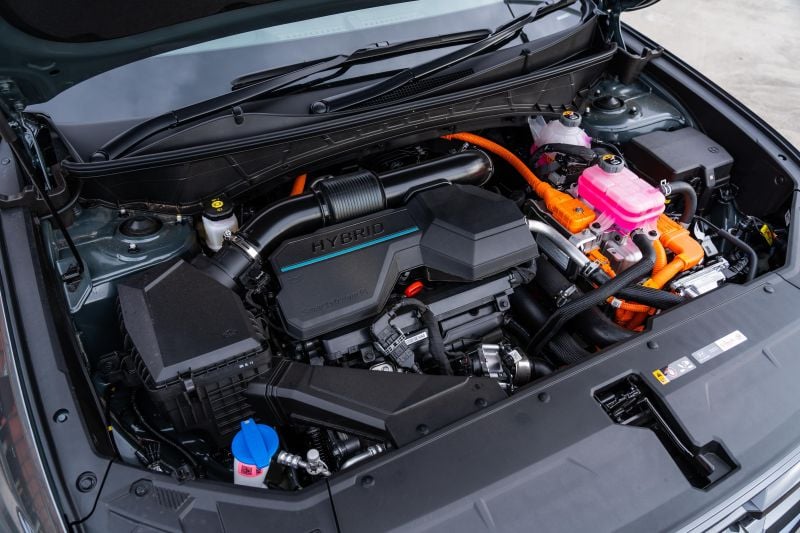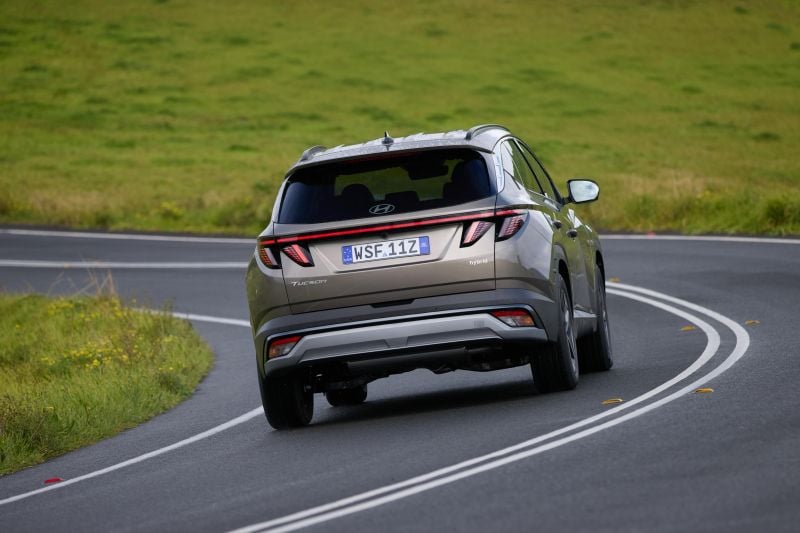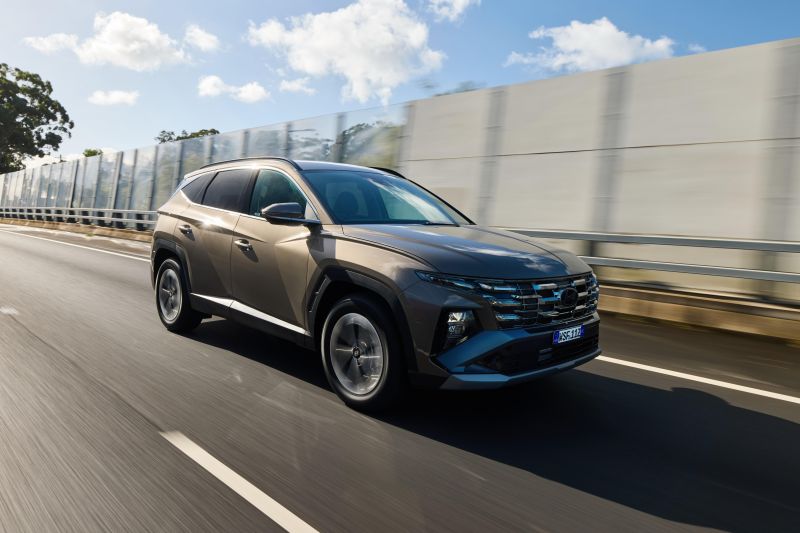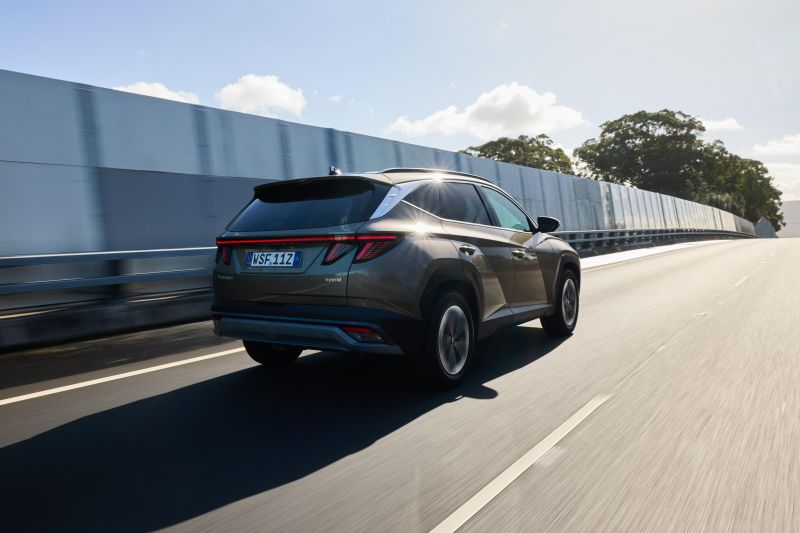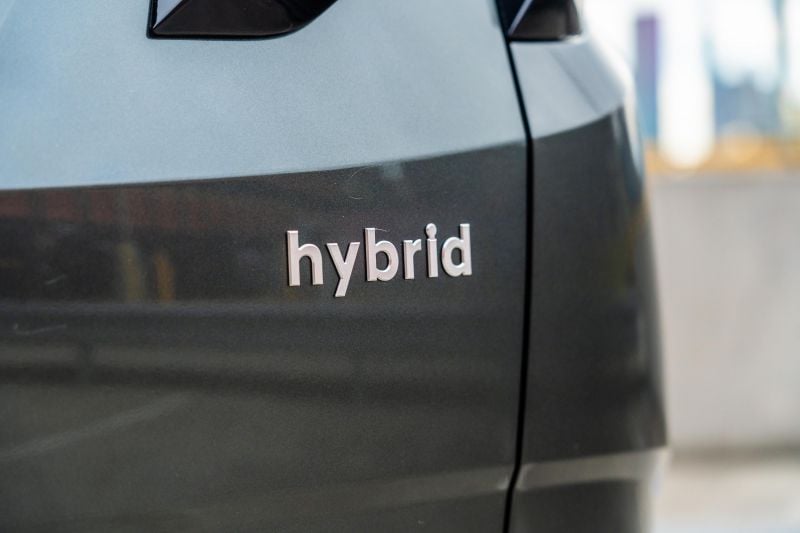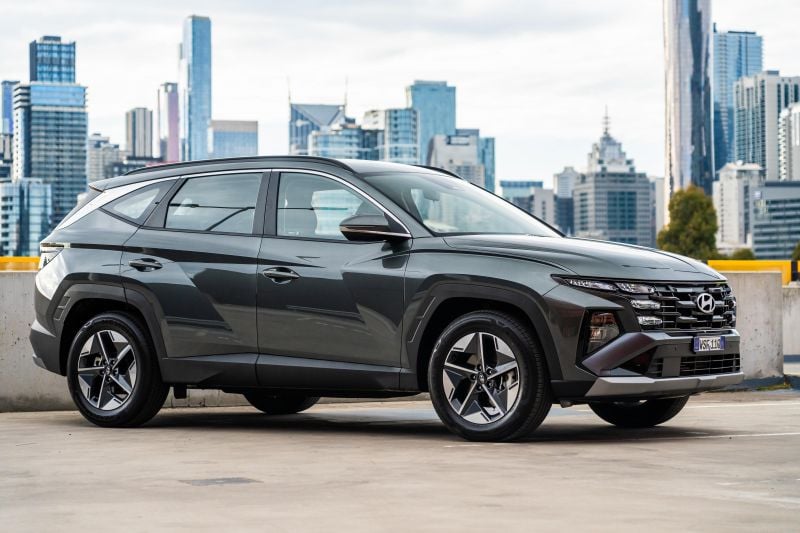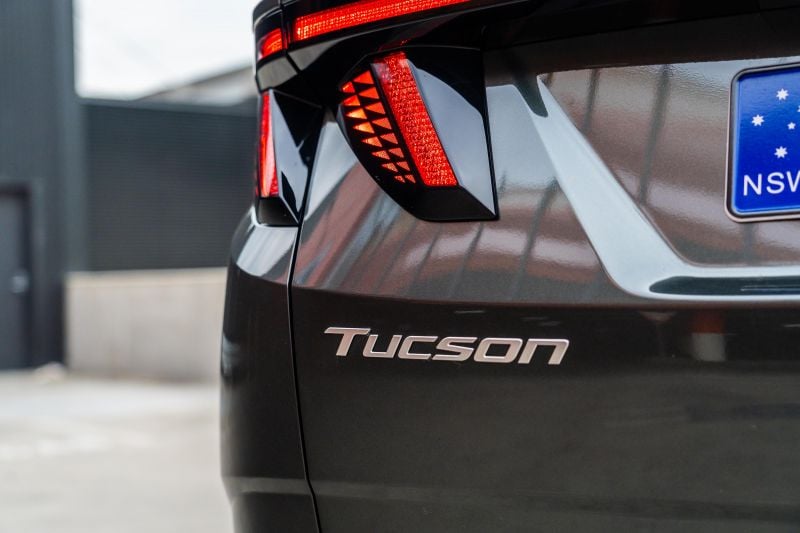Look out, Toyota. Hyundai is coming for the RAV4 Hybrid, and it’s launched with all guns blazing.
Rather than one expensive variant, hybrid power is available across the 2025 Hyundai Tucson lineup. Pricing starts just over $45,000 before on-road costs for the base hybrid front-wheel drive on test here, but you can spend more than $60,000 if having powered, heated, cooled, and leather everything is a priority.
Although it’s a hybrid SUV that’s roughly the same shape and size as a RAV4, the Tucson isn’t a Korean clone.
Its hybrid system combines a turbocharged petrol engine with an electric motor, and rather than slurring through a CVT it packs a six-speed automatic transmission designed to deliver a more natural, engaging driving experience.
Regardless of whether you opt for a hybrid or not, the new Tucson has been given a significant makeover inside. Gone is the busy, gloss black waterfall between the seats, and in its place is a cleaner setup – above which sits a flash new dual-screen display.
In other words? This might be a mid-life facelift, but Hyundai has made significant changes to the Tucson beyond its hybrid powertrain.
How does the Hyundai Tucson compare?
View a detailed breakdown of the Hyundai Tucson against similarly sized vehicles.

Hyundai
Tucson
How much does the Hyundai Tucson cost?
Want choice? Hyundai offers plenty in the Tucson range, which starts just below $40,000 before on-road costs and extends beyond $60,000 before on-roads for the first time.
| Model | Price before on-roads |
|---|---|
| 2025 Hyundai Tucson 2.0-litre FWD | $39,100 (+$3450) |
| 2025 Hyundai Tucson turbocharged 1.6-litre hybrid FWD | $45,100 (NEW) |
| 2025 Hyundai Tucson N Line turbocharged 1.6-litre FWD | $45,100 (NEW) |
| 2025 Hyundai Tucson N Line turbocharged 1.6-litre hybrid FWD | $49,100 (NEW) |
| 2025 Hyundai Tucson Elite 2.0-litre FWD | $44,100 (+$3450) |
| 2025 Hyundai Tucson Elite turbocharged 1.6-litre FWD | $46,100 (NEW) |
| 2025 Hyundai Tucson Elite turbocharged 1.6-litre AWD | $48,600 (+$3950) |
| 2025 Hyundai Tucson Elite turbocharged 1.6-litre hybrid FWD | $50,100 (NEW) |
| 2025 Hyundai Tucson Elite turbocharged 1.6-litre hybrid AWD | $52,600 (NEW) |
| 2025 Hyundai Tucson Elite N Line turbocharged 1.6-litre FWD | $48,600 (NEW) |
| 2025 Hyundai Tucson Elite N Line turbocharged 1.6-litre AWD | $51,100 (+$3950) |
| 2025 Hyundai Tucson Elite N Line turbocharged 1.6-litre hybrid FWD | $52,600 (NEW) |
| 2025 Hyundai Tucson Elite N Line turbocharged 1.6-litre hybrid AWD | $55,100 (NEW) |
| 2025 Hyundai Tucson Premium turbocharged 1.6-litre AWD | $55,600 (+$3950) |
| 2025 Hyundai Tucson Premium turbocharged 1.6-litre hybrid AWD | $59,600 (NEW) |
| 2025 Hyundai Tucson Premium N Line turbocharged 1.6-litre AWD | $57,100 (+$3950) |
| 2025 Hyundai Tucson Premium N Line turbocharged 1.6-litre hybrid AWD | $61,100 (NEW) |
To see how the Tucson lines up against the competition, check out our comparison tool.
What is the Hyundai Tucson like on the inside?
This is a much better presented space than before. Gone is the gloss black waterfall of fiddly touch buttons, replaced with a clean new dashboard that’s better to look at, and better to use on the move.
The new dual-screen display setup could have been lifted from something German, and even the basic digital dash on this entry model doesn’t cheapen things.
The fundamentals remain excellent, too. The driving position is accomodating for tall drivers, the view over the bonnet is commanding enough to give buyers the SUV feeling they crave. This is quite a big car by mid-sized SUV standards, but solid vision in every direction means it doesn’t necessarily feel it.
Quality is excellent. The flat-bottom steering wheel looks and feels expensive, and all the places you poke, prod, or rest an elbow are soft to the touch. As base models go, this is a pretty damn nice one.
Hyundai has made huge strides forward when it comes to interior technology. The 12.3-inch touchscreen standard here looks expensive, and touches like having the shortcut buttons in the bottom right-hand corner of the screen instead of the top left make life easier in right-hand drive Australia.
Wireless Apple CarPlay and Android Auto are rolling out across the Hyundai lineup after years of being excluded from vehicles with factory satellite navigation, finally giving the brand’s hero cars a properly up-to-date feature set.
Connectivity comes courtesy of a pair of USB-C ports and a 12V outlet, housed ahead of an open space at the base of the dashboard.
Storage spaces abound. Along with the cupholders and wireless phone charger near the armrest, there’s a space big enough for a handbag beneath it – just beware, it’s not covered so leaving things there when the vehicle is locked is a risk in some parts of town.
Rear legroom and headroom remain Tucson strong points. The doors are nice and large, and open close to 90 degrees to make loading children into seats easier than it otherwise would be.
Air vents, USB ports, and a fold-down central armrest all feature back there, and there are two ISOFIX and three top tether points for child seats.
Unlike in some rivals, the rear bench doesn’t slide back and forward. But it does fold 60-40, and when folded it creates a flat load space.
There’s also not much need for a sliding bench given how big the boot is to start with.
It’s a long, flat space that’ll easily take a set of golf clubs or a large pram – and one that doesn’t require too much Tetris if you’re to pack in a weekend’s worth of stuff for a family.
| Dimensions | Hyundai Tucson Hybrid |
|---|---|
| Length | 4640mm |
| Width | 1865mm |
| Height | 1665mm |
| Wheelbase | 2755mm |
| Cargo capacity | 582 litres (5-seat) 1903 litres (2-seat) |
To see how the Tucson lines up against the competition, check out our comparison tool.
What’s under the bonnet?
Three powertrains are offered across the Tucson lineup, headlined by the new hybrid you see here.
| Specifications | Hyundai Tucson Hybrid |
|---|---|
| Engine | 1.6L 4cyl turbo hybrid |
| Engine outputs | 132kW/264Nm |
| Electric motor outputs | 37.4kW/264Nm |
| System outputs | 172kW/350Nm |
| Battery | 1.49kWh lithium-ion |
| Transmission | 6-speed auto |
| Driven wheels | FWD |
| Weight | 1745kg (kerb) |
| Fuel economy (claimed) | 5.3L/100km |
| Fuel economy (as tested) | 6.0L/100km |
| Fuel tank capacity | 52 litres |
| Fuel requirement | 91 RON |
| CO2 emissions | 122g/km (FWD) |
| Emissions standard | Euro 5 |
| Braked tow capacity | 1900kg |
To see how the Tucson lines up against the competition, check out our comparison tool.
How does the Hyundai Tucson drive?
Hyundai takes a very different approach to Toyota and Nissan with its hybrids.
Toyota blends electric and petrol power through a CVT for a smooth, slightly slurry experience, while Nissan mostly uses the petrol engine to charge a battery, which in turn powers an electric motor.
In the Tucson, both the petrol and engine operate through a six-speed automatic transmission. On light inputs, the electric motor gradually works through the gears; put your foot down harder and the petrol engine kicks in to help it, revving out towards the redline like a conventional petrol car.
If you enjoy driving, it’s a more natural and enjoyable experience. It also feels very electric.
The Tucson will accelerate to more than 50km/h on battery power if you’re gentle with the accelerator, and the petrol engine often cuts out at an 80km/h cruise. When the engine does fire, it does so smoothly and quietly.
Unlike the Kona Hybrid, which feels a bit underpowered when you really put your foot down, the turbocharged petrol in the Tucson packs plenty of punch. There’s enough grunt to spin the front wheels without too much effort in the wet, which may be enough to nudge buyers into an AWD.
Combined with the quiet, efficient hybrid system, the Tucson’s light steering and comfortable ride make for an excellent commuter.
Despite its size you can confidently slice down tight laneways, and even grandmas will be able to reverse park it with one hand. Hyundai’s cameras aren’t quite GWM Haval levels of clear, but they’re better than the dross on offer in some rivals.
It’s a settled cruiser as well. Ride comfort is excellent in this base model, with its chubby tyres filtering out pimply city streets better than the slim tyres and fancy wheels on the N Line above it in the range, while the lack of any sporting credentials means Hyundai has dialled in a relaxed highway ride.
There’s a hint of floatiness over big highway crests and dips, but for the most part the Tucson just gets on with the job.
I can’t help but wonder if a seventh gear would make it even better, by allowing the car to settle down further on the highway rather than spinning at around 2000rpm when you’re doing the legal limit in Australia.
Road noise is well suppressed, and Hyundai’s adaptive cruise control smartly maintains a gap to the car in front. The lane-keeping assist steps in when required to nudge you back between the white lines.
The active lane centring remains too active for my liking, trying to grab the wheel from your hands rather than working with you.
Hyundai also deserves credit for (almost) fixing its active speed limit warning system. You can now silence the beeps with a long press of the mute button, which is much easier than the previous sequence of steering wheel buttons and touchscreen inputs.
You know what would be even better though? Being able to turn it off permanently.
What do you get?
There are three trim levels in the updated Tucson lineup. On test here is the entry-level Hybrid 2WD.
Hyundai Tucson highlights:
- 18-inch alloy wheels
- Full-size spare wheel (non-hybrid only, hybrids have a space-saver)
- Dark chrome front grille
- Roof rails
- LED headlights
- LED daytime running lights
- LED side indicators
- LED tail lights
- Heated and auto-folding side mirrors
- Cloth interior upholstery
- 4.0-inch instrument cluster display
- 12.3-inch touchscreen infotainment system with over-the-air updates
- 6.6-inch climate control panel
- Wireless Apple CarPlay and Android Auto
- Digital radio
- 4 x USB-C outlets
- 6-speaker sound system
- Wireless phone charger
- Electronic parking brake
- Leather-wrapped steering wheel
- Leather-wrapped shifter
- Premium cloth dashboard and door centre trim
- Black cloth upholstery
- Power driver’s seat lumbar
- Bluelink connected services
- Remote control of climate and vehicle functions
- Vehicle settings management
Tucson Hybrid adds:
- E-Motion Drive
- Smart regeneration braking
- Paddle shifters
- After-blow system
Is the Hyundai Tucson safe?
The Hyundai Tucson received a five-star ANCAP safety rating in 2021.
| Category | Rating |
|---|---|
| Adult occupant protection | 86 per cent |
| Child occupant protection | 87 per cent |
| Vulnerable road user protection | 66 per cent |
| Safety assist | 70 per cent |
Standard safety features include:
- 7 airbags
- Front, front-side, and curtain airbags plus a front-centre airbag
- Autonomous emergency braking (AEB)
- Pedestrian detection
- Cyclist detection
- Junction assist
- Adaptive cruise control with stop/go
- Blind-spot assist
- Rear cross-traffic assist
- Intelligent speed limit assist
- Lane-keep assist
- Lane centring
- Reversing camera
- Rear parking sensors
- Leading vehicle departure alert
- Second row pretensioner seat belts
- Safe exit warning
- Rear occupant alert
- Tyre pressure monitoring
- Hyundai Bluelink connectivity:
- Automatic collision notification
- Emergency call (SOS) function
- Alert services including geo-fencing, valet, speed and time alerts
The mid-range Elite and Premium variants gain advanced rear occupant alert, a navigation-based Smart Cruise Control, and Highway Driving Assist, the latter of which combines the adaptive cruise control and lane-keeping systems.
Premium grades also get a blind-spot view monitor, rear AEB and a surround-view camera.
How much does the Hyundai Tucson cost to run?
Running costs in the Tucson Hybrid are higher than those of the best-selling Toyota RAV4 Hybrid, and owners who drive long distances should note the 10,000km service intervals.
| Running costs | Hyundai Tucson Hybrid |
|---|---|
| Warranty | 5 years, unlimited kilometres (vehicle) 8 years or 160,000km (HV battery) |
| Roadside assistance | Lifetime (service activated) |
| Service intervals | 12 months or 10,000 kilometres |
| Capped price servicing | 5 years |
| Total capped price service cost | $2040 |
CarExpert’s Take on the Hyundai Tucson
This is what we’ve been waiting for from Hyundai.
The Tucson is a bona-fide Toyota RAV4 rival we don’t need to make excuses for. It’s offered in a range of trim levels, offers impressive efficiency, and the price hike from petrol to hybrid isn’t exorbitant.
Although it’s not quite a parsimonious as its main Toyota rival, the Tucson counters with a more enjoyable driving experience. It’s also more modern inside, even in the base trim tested here.
It’s taken its time getting here, but the Tucson Hybrid was worth the wait.
Interested in buying a Hyundai Tucson? Get in touch with one of CarExpert’s trusted dealers here
Click the images for the full gallery
MORE: Everything Hyundai Tucson

